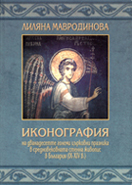Иконография на дванадесетте големи църковни празника в средновековната стенна живопис в България (ІХ–ХІV в.)
The Iconography of the Great Feasts of the Orthodox Church in Mediaeval Frescoes from Bulgaria (9th-14th Century)
Author(s): Lilyana Mavrodinova
Subject(s): Christian Theology and Religion, History, Fine Arts / Performing Arts, Cultural history, Visual Arts, Theology and Religion, Eastern Orthodoxy
Published by: Кирило-Методиевски научен център при Българска академия на науките
Keywords: medieval iconography; Great Orthodox feasts; Eastern Christian iconography; Bulgarian medieval frescoes; Byzantine art
Summary/Abstract: The Iconography of the Great Feasts of the Orthodox Church in Mediaeval Frescoes from Bulgaria (9th-14th Century)
This study aims to present the developments of the medieval iconography of the Great Orthodox feasts in Eastern Christian states, first of all in Byzantium, in summary and accessible form, by highlighting the place and characteristics of the monuments in Bulgarian lands.
It is outlined, albeit sparingly, the place of the Bulgarian monuments in the context of medieval Eastern Christian iconography in terms of the twelve biggest church feast.
There are shown the main sources and the development of iconographic schemes and details, as well as the preferences of donors and masters for one or another type of image.
In shaping of iconography of Byzantine cultural community, researchers have identified a combination of Syro-Palestinian base, Hellenistic techniques and borrowings from triumphant imperial art. When the Bulgarian people accept Christianity, these elements are already assimilated by the Byzantine art of the victorious iconodules and superimposed in our country over the old traditions and practices of art from Pliska and Preslav, preserved the memory of earlier influences in touch with the peoples of the East. The taste for drama in some of the Bulgarian monuments, mostly from the periphery of the country, connecting them with pre-Iconoclasm eastern models. At the heart of the iconography of most of the official monuments from the Second Bulgarian Kingdom, there is a balance between the older Eastern tradition and the elegance of more classic monuments from the Byzantine capital. Perhaps here we have a complex influence of tradition and new events subdued for some time the power of Constantinople as an artistic center, conquered by the Crusaders.
The iconography of the Bulgarian medieval frescoes fits into the mainstream of the Eastern Christian iconography dominated by Byzantium, as it is associated primarily with the monuments of the neighboring Balkan countries. Many details, however, testify to the close relation to other nations of the Eastern Christian art community, such as Russians, Georgians, Armenians, and Ukrainians. After the Crusades, there can be found some iconographic elements typical of the art of Western Europe, but, given the influences and interrelationships of the Roman area with Byzantium and its eastern provinces and greater cultural exchanges, there is more to say on this issue despite some valuable studies.
- Print-ISBN-10: 957-9787-12-5
- Page Count: 156
- Publication Year: 2005
- Language: Bulgarian, French
- Table of Content
- Sample-PDF
- Introduction
- eBook-PDF

